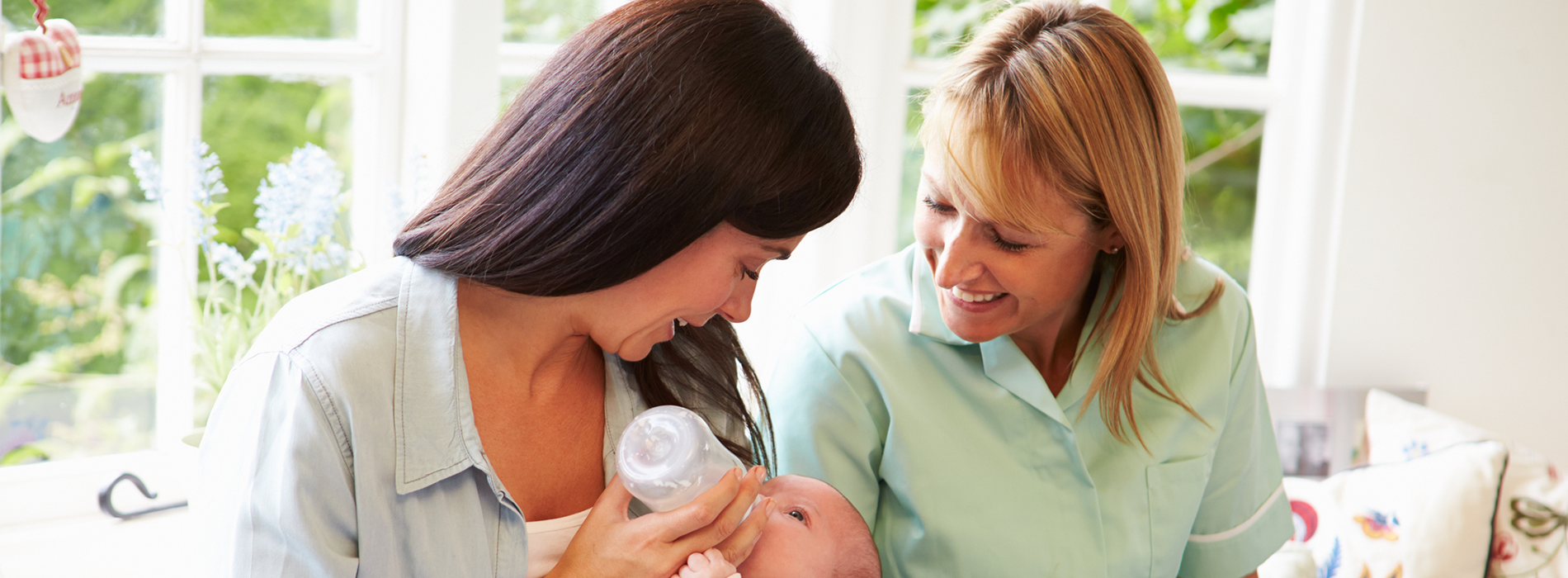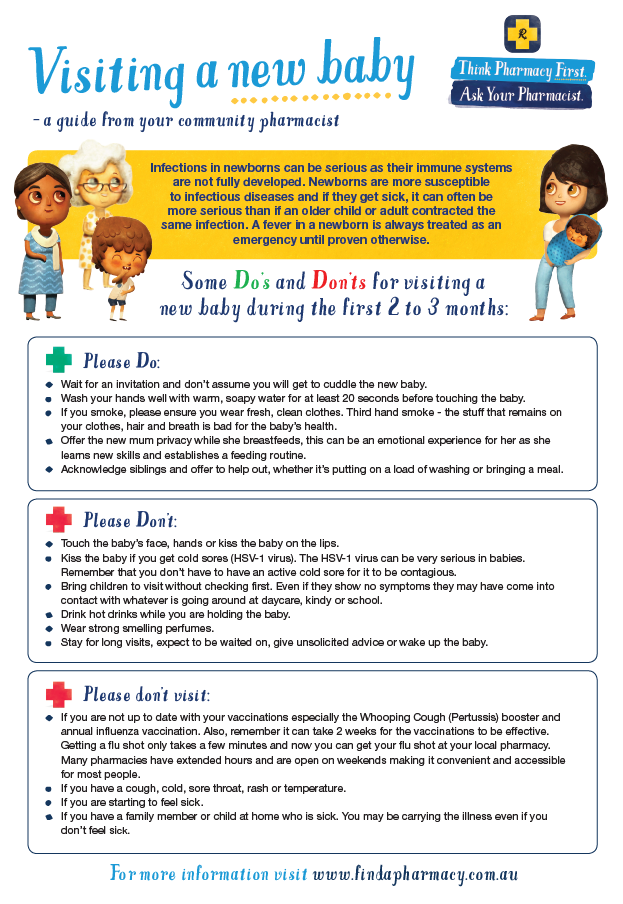
Bringing Home Your New Baby – The First 3 Months
Bringing home your new baby is a wonderful experience, however, this little person is still completely new to you and it will take a while for you to know what is and isn’t ‘normal’ for your baby. You might find the first few weeks and months quite stressful whether you’re a first time parent or not.
You can use this handy checklist from our pharmacist to advise visitors what they should and shouldn't do when visiting you and your new baby!
The first 3 months are often referred to as the ‘Fourth Trimester’. It is a period of major development for your baby as they adjust to life outside the womb. While some babies adjust easily, others find it harder to get used to the new noises, sights and sensations.
You will also go through a period of adjustment as you get used to life with your new baby. Each baby is unique and you may find yourself unsure, confused and overwhelmed from time to time. In the middle of all this change you will also have to contend with many well-meaning family and friends who pop in to see the baby. While it is a good idea to limit visits to your newborn because of the risk of infections, it can be difficult to say ‘no’ without feeling like you will offend someone. This useful guide from your community pharmacist provides some do’s and don’ts for visitors that will help to keep your baby safe from colds and flu while their immune system matures.
When your baby cries for what feels like hours on end or has some strange coloured nappies, you may find yourself wondering “is this normal?’. It can be hard to know whether something requires a visit to your GP or whether it is just a part of your baby’s development. The good news is there is plenty of support available, including your community pharmacist. With most people living only a few kilometres from a pharmacy, your pharmacist is easily accessible and is there to answer your questions when you’re feeling unsure. Many pharmacies offer Mother and Baby Clinics and can provide advice and products to help you treat minobreastfeeding. They will also refer you to a doctor if necessary.
Is this normal……
Here are some of the lumps, bumps and areas of concern you may have during your baby’s first 3 months:
| Symptoms | What could it be? | Treatment |
|---|---|---|
Crying - our baby seems to cry more in the evening, pulling up their knees, clenching their little fists and arching their back. | Colic occurs in otherwise healthy babies usually between week two and up to four months. | While this can be very stressful for you, colic is harmless. Speak to your pharmacist about dietary changes you can make if you are breastfeeding and products that can help with digestion and help manage colic. |
| Skin - yellow, greasy scales on the baby's scalp, body folds or torso that occur in the first three months. | Cradle cap is a type of seborrheic dermatitis that occurs when your baby's skin makes too much oil or sebum. | Ask your pharmacist about suitable products and techniques to soften the skin scales. It's important not to pick at the flakes as this can lead to infection. |
| Nappy area - bright red rash in the nappy area that looks red and raw. | Nappy rash is caused by the moisture from urine and faeces as well as the friction from the nappy which damages the skin. Secondary bacterial or fungal infection can also occur. | Change nappies more often and talk to your pharmacist about your baby's skincare routine. Your pharmacist can suggest products that might prevent the problem from occurring and creams that offer relief and clear up the symptoms. |
| Spitting up - Your baby swallows milk and it comes back up. They may appear to be in pain, crying, irritable, vomiting and sleeping poorly. | Gastroesophageal reflux (GER) is indigestion due to an immature digestive system. It is quite common and improves as your baby's digestive system matures. | While it isn't usually a sign of illness, in some infants it can cause distress. Your pharmacist can discuss strategies to prevent reflux and answer questions you may have about medications your baby has been prescribed. |
| Poo - There is a change to the colour, consistency or frequency of bowel movements. | The frequency and colour of your baby's bowel movements will differ depending on their gut function and whether they are bottle or breast-fed. | Speak to your pharmacist if oyu have concerns about changes in your baby's bowel motions and if you are worried about the effect of any medication you or your baby may be taking. Diarrhoea causes fluid loss and can cause severe dehydration in infants - seek emergency assistance. |
| Feeding issues - Breast or bottle refusal; you are worried that you are not producing enough milk, or you are experiencing breastfeeding problems. | Whether breast or bottle-feeding, you may have questions about how much, how often and your feeding technique. | Your pharmacist can provide you with current and accurate evidence-based information on breastfeeding and bottle feeding as well as answer questions you may have about the safety of medications while breastfeeding. |
| Sleeping patterns - From only catnapping to sleeping through, settling techniques and feeling sleep deprived. | Newborn babies will need to feed regularly during the night and though it might feel like the sleepless nights will never end, eventually, your baby will sleep for longer stretches. | Many pharmacies offer Mother and Baby Clinics where you can ask about settling routines. Sleep deprivation can make everyday tasks much harder, but if you find you are struggling to cope, speak to your pharmacist. Many pharmacists undertake additional training in mental health and can provide helpful advice as well as refer you to sources of support. |
| Nails - Your baby's sharp nails scratch their face. | While a newborn's nails are quite soft, they can also be quite sharp. | Ask your pharmacist about suitable products for keeping your baby's nails short and use it after a bath when their nails are soft. |
| Umbilical cord - Cleaning the umbilical cord stump. | Once the umbilical cord is cut the stump will dry out and eventually fall off. | It's important to gently clean the area around the stump and keep the nappy away from the navel until it heals. If there is any redness, oozing or swelling around the area, your baby may have an infection and you should see your GP. |
| Baby acne - A bumpy skin-coloured rash on your baby's cheeks, forehead and chin and occasionally the back of the neck and shoulders. | Baby acne, newborn acne or milk rash is quite common in the first few weeks after your baby's birth. It is thought to be caused by the transfer of hormones from mother to baby. | This doesn't usually cause your baby any discomfort and normally doesn't require any treatment. |
| Flat head - A flattened spot on the back or the sides of your baby's head. | Plagiocephaly refers to an unusually shaped head or flattened spot on the back or side of your baby's head. This occurs because a newborn's skull bones are soft and flexible | Your baby's head usually returns to a normal shape by about two months. If you are concerned or your baby has difficulty turning their head, speak to your GP. |
You can read more information about Mother and Baby Clinic services at your local pharmacy here.
